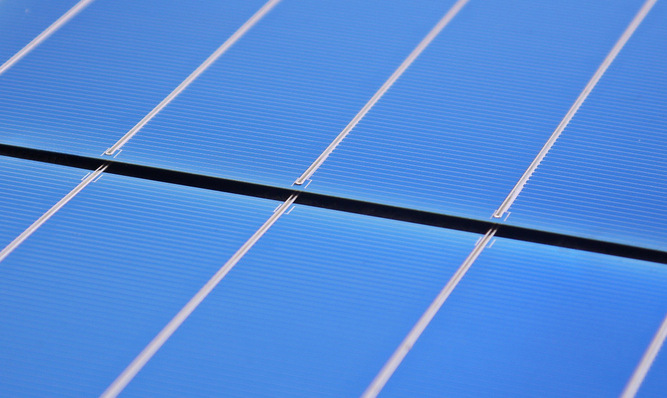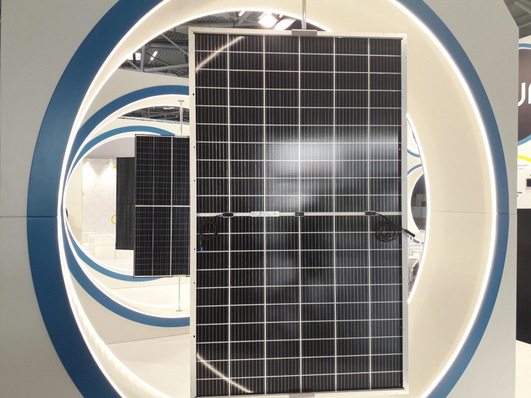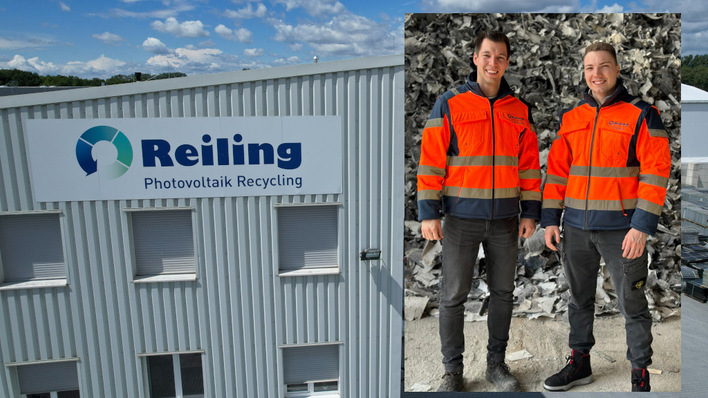Any production process requires energy, yet critics are fast to point out that while PV products support the generation of renewable energy, the early stages of their production leaves an energy consumption footprint.
Energy consumption management
The first step towards improving the carbon footprint in manufacturing is lowering this energy consumption. Manufacturers have therefore implemented internal rules and regulations, including energy and resource management, as well as measurement procedures, to continuously consolidate the awareness of energy consumption and to optimise energy efficiency. Standards such as the ISO 50001 Energy Management System Certification help to demonstrate a manufacturers successful implementation of policies that help to lower energy consumption. In the two years from 2020 to 2022, energy consumption for cell products and modules has already been reduced by up to 50 percent by some leading manufacturers.
Utilising renewable energy
Photovoltaic companies produce and deliver important components for the next generation of renewable energy with the goal of making energy consumption more sustainable around the globe. Therefore, it makes sense that PV manufacturers utilise renewable energy resources for their own energy demands. This can be solar panels on productions and office facilities, owned renewable power plants or purchased green power. The first PV companies have already set goals of utilising 100 percent renewable energy in global production operations within this decade. In addition, there are already manufacturing facilities and whole business parks operating with 100 percent renewable energy.
Material and product lifecycle management
Green and low-carbon manufacturing along with carbon emission control affect all aspects of a photovoltaic product’s life cycle. As part of a low-carbon design process, it should be systematically considered what the impact on resources and the environment in the selection, production, distribution, use, recycling, and disposal of raw material is. On this basis, organisations can strive to use as many harmless raw materials as possible to achieve a green and low-carbon development. One example is the use of a dual-glass structure versus glass/backsheet modules. By this technology shift alone, about 1kg of plastic material can be saved per dual glass module.
There are certifications that verify industry-leading low carbon emissions in the manufacturing process, such as "Industrial Product Green Design Demonstration Enterprise" or Life Cycle Assessment (LCA) certification for PV modules by TÜV Rheinland in Germany, that companies can apply for to demonstrate their environmentally responsible design and lifecycle practices.
In addition to material selection and lifecycle management, the end-of life processes for products and recycling options for these are also pivotal for the overall sustainability results.
Water management and conservation
As the global population rises and climate warms, the pressure on global water resources continues to increase. Aware of the importance of sustainable water use, PV companies proactively assume responsibility by setting water intensity targets and taking measures to ensure a steady decline in water intensity over the years in compliance with laws, regulations and beyond.
Through equipment modification, technology upgrading, reclaimed water reuse and other measures, factories can maximise water efficiency in production and operation. This way, water consumption, specifically in module production processes, can be lowered by more than 50 percent.
Wastewater management is another important area. For this, wastewater should be classified into industrial wastewater and domestic sewage and corresponding measures for treatment. A high percentage of wastewater can be recycled, and wastewater that cannot be recycled needs to be treated to meet corresponding standards before discharge.
Waste management
To minimise the impact on the environment, companies should continuously improve and refine the management of solid waste and exhaust gas generation and emissions from the production process, striving to reduce the emissions and ensure that all emissions are treated in accordance with the regulations.
Waste management procedures should be binding for both employees and contractors and be strictly supervised. This includes the generation, collection, classification, storage, transfer, and disposal of waste. For example, raw material waste such as aluminium frames can be directly scrapped in the production line, transported to warehouses for temporary storage, and finally recycled by the manufacturers or qualified waste disposal enterprises. Waste products such as waste silicon wafers and waste cells can be collected by the production departments, and those that cannot be recycled can be delivered to qualified waste disposal enterprises for treatment and recycling. Hazardous waste such as organic solvents, oils, empty chemical containers, etc. should be collected, sorted, and then recycled or disposed in compliance with the regulations by qualified hazardous waste disposal operators. Packaging waste such as paper boxes, foam, and plastics are an additional area of waste management. Reducing packaging, introducing material recycling practices, and actively working with upstream and downstream suppliers to track and recycle packaging materials of products can improve the processes significantly and can result in recycling rates of about 80 percent.
Exhaust gas in PV manufacturing mainly consists of greenhouse gases, particulate matter, and nitrogen oxides from the use of purchased electricity and combustion of natural gas. To improve the management of exhaust gas emissions, exhaust gas sensing devices can be installed to enable real-time monitoring, ensuring that the exhaust gas can be treated before emission.
Furthermore, on-site environmental tests and test reports by qualified third-party institutions can support full transparency of the gas and waste management processes.
Carbon emission management and low-carbon practices
Forward-looking PV companies have established greenhouse gas data and quality management procedures, and also actively promote the process of carbon inventory and carbon foot printing to provide transparent and scientific verification data for the low-carbon development of their organisation. This can include GHG inventories in accordance with ISO 14064 and third-party data certification.
Did you miss that? Sustainability and more
The low-carbon practices do not only apply to the manufacturing processes, but also to a company’s offices. This applies from energy consumption and utilising renewable energy, to greening employees transport and travel habits, to waste management and recycling processes. This may also include reducing paper or printing toner cartridges through digital transformation, such as an online management platform and OA systems.
Green and zero emission factories
All these practices combined help manufacturers to establish greener or even zero emission factories. With this goal in mind, they establish internal environmental management systems in accordance with ISO 14001 and obtain ISO 14001 Environmental Management System Certification. Factories successfully implementing green practices can apply for ‘Green Factory’ and ‘Green Building’ certifications.
For a Zero Carbon Factory (Type 1) Certificate, a range of indicators are evaluated, including: energy and resource utilisations; greenhouse gas reduction implementation; carbon offset implementation; intelligent information management systems for energy and carbon emissions; infrastructure; product design; and the fulfilment of compliance and management requirements. Only if a set of very strict requirements has been reached, the certification is granted. The first PV manufacturers have fulfilled these requirements and show that the PV industry is on its way to become even more sustainable.

Trina Solar
Stakeholder involvement and transparency
Sustainable development cannot be achieved without the input and participation of stakeholders, and it is therefore important to encourage an active and open dialogue. This should include a regular outreach to collect the views and suggestions of internal stakeholders such as employees and management, as well as the expectations and responses of external stakeholders such as government and regulatory bodies, shareholders and investors, customers, suppliers and partners, media, community, and NGOs.
Open dialogue, as well as expert advice and the review and management by an Environmental Health & Safety (EHS) committee, can then result in environmental management manuals, including environmental, occupational health and safety and energy management. The EHS committee should regularly update the organisational structure and the management system to meet and go beyond international and domestic regulatory requirements, proactively undertake environmental responsibilities, and lead the green development. Employees should receive timely training to understand new EHS-related laws, regulations, and industry standards.
Did you miss that? Stringer pioneer focuses on innovation and "made in Europe"
In addition, sustainability and CSR reports provide the necessary transparency to all stakeholders to review the progress achieved and to take informed decisions.
All this helps driving clean energy technology innovation, finding ways to make manufacturing and business processes more sustainable and to reduce the ecological impact while ensuring product safety and quality.
Progress is clearly visible
Trina Solar has pursued the goal of a net-zero future and the sustainable development of our business for more than 25 years. We think that it is essential not only to continuously improve green practices but also to provide transparent corporate sustainability-related information to all stakeholders. Ultimately this will help improve not only our industry but also help partners and end customers to select the most sustainable solutions. For a long time, product pricing was a dominant factor in selecting solutions, but we see more and more customers who also want to know how sustainable the products they select are. This can be with regards to the CSRD and ESG reporting of enterprises investing into or purchasing photovoltaic solutions, or the individual goal of residential property owners who want to be sure the rooftop PV system they choose is the most sustainable solution. (GV/hcn)








